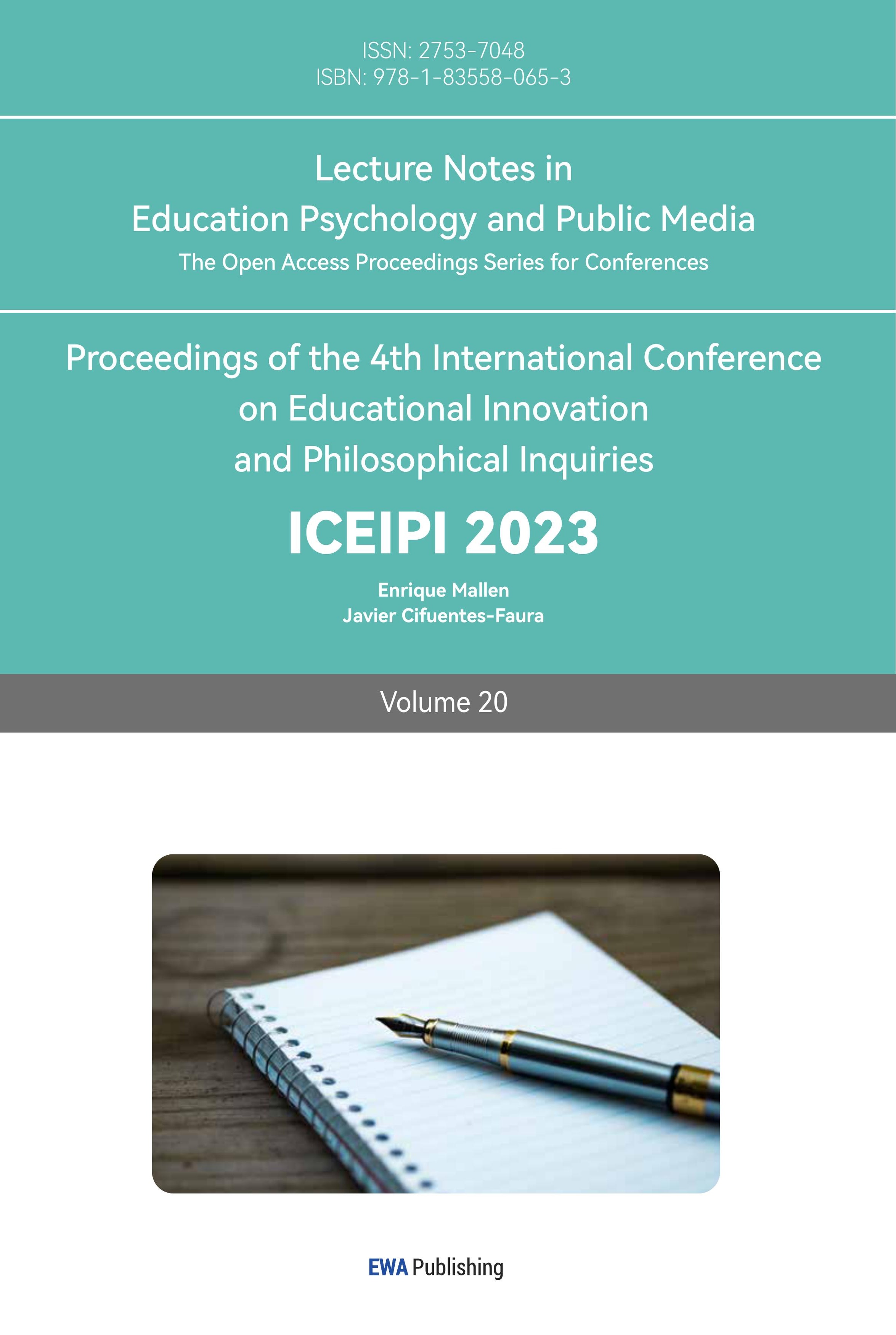References
[1]. Zhou Li, On the necessity of Adding Phonetic Content to College English Teaching [J]. Journal of Chuxiong Normal University, 2010,25(12): 63-65.
[2]. Sparkman, Colley F, The Value of Phonetics in Teaching a Foreign Language [J]. The Modern Language Journal, 1926, 10(4): 227–35.
[3]. Gan Daixia, A Study on Phonetics of English Majors [J]. Journal of Xichang College (Social Science Edition), 2009, 21(02): 1673-1883.
[4]. Gao Xiang, Transfer Phenomenon in English Phonetics Learning and Phonetics Teaching [J]. Foreign Language Teaching, 2002(03): 46-49.
[5]. Odlin Terence, Language Transfer [M]. Shanghai: Shanghai Foreign Language Education Press, 2001.
[6]. Ellis R, The Study of Second Language Acquisition [M]. Oxford: Oxford University Press, 1994.
[7]. Ruan Qian, Huang Yi Fei. An analysis of negative transfer of native speech sounds in English Learning [J]. Journal of Fujian Agriculture and Forestry University (Philosophy and Social Sciences Edition), 2008(02): 110-112.
[8]. Wang Qian, English teaching from the perspective of contrastive linguistics [J]. English Abroad, 2019, (01): 206-207.
[9]. Li Tingxiang, English Teaching Methods, Beijing Higher Education Press, 1983.
[10]. Luo Lisheng, Zhang Laixiang, A review of English Pronunciation Teaching and some suggestions for current English Pronunciation Teaching [J]. Foreign Languages and Foreign Language Teaching, 2002(10): 21-23.
Cite this article
LI,Z. (2023). Analysis of College English Phonetic Learning. Lecture Notes in Education Psychology and Public Media,20,60-65.
Data availability
The datasets used and/or analyzed during the current study will be available from the authors upon reasonable request.
Disclaimer/Publisher's Note
The statements, opinions and data contained in all publications are solely those of the individual author(s) and contributor(s) and not of EWA Publishing and/or the editor(s). EWA Publishing and/or the editor(s) disclaim responsibility for any injury to people or property resulting from any ideas, methods, instructions or products referred to in the content.
About volume
Volume title: Proceedings of the 4th International Conference on Educational Innovation and Philosophical Inquiries
© 2024 by the author(s). Licensee EWA Publishing, Oxford, UK. This article is an open access article distributed under the terms and
conditions of the Creative Commons Attribution (CC BY) license. Authors who
publish this series agree to the following terms:
1. Authors retain copyright and grant the series right of first publication with the work simultaneously licensed under a Creative Commons
Attribution License that allows others to share the work with an acknowledgment of the work's authorship and initial publication in this
series.
2. Authors are able to enter into separate, additional contractual arrangements for the non-exclusive distribution of the series's published
version of the work (e.g., post it to an institutional repository or publish it in a book), with an acknowledgment of its initial
publication in this series.
3. Authors are permitted and encouraged to post their work online (e.g., in institutional repositories or on their website) prior to and
during the submission process, as it can lead to productive exchanges, as well as earlier and greater citation of published work (See
Open access policy for details).
References
[1]. Zhou Li, On the necessity of Adding Phonetic Content to College English Teaching [J]. Journal of Chuxiong Normal University, 2010,25(12): 63-65.
[2]. Sparkman, Colley F, The Value of Phonetics in Teaching a Foreign Language [J]. The Modern Language Journal, 1926, 10(4): 227–35.
[3]. Gan Daixia, A Study on Phonetics of English Majors [J]. Journal of Xichang College (Social Science Edition), 2009, 21(02): 1673-1883.
[4]. Gao Xiang, Transfer Phenomenon in English Phonetics Learning and Phonetics Teaching [J]. Foreign Language Teaching, 2002(03): 46-49.
[5]. Odlin Terence, Language Transfer [M]. Shanghai: Shanghai Foreign Language Education Press, 2001.
[6]. Ellis R, The Study of Second Language Acquisition [M]. Oxford: Oxford University Press, 1994.
[7]. Ruan Qian, Huang Yi Fei. An analysis of negative transfer of native speech sounds in English Learning [J]. Journal of Fujian Agriculture and Forestry University (Philosophy and Social Sciences Edition), 2008(02): 110-112.
[8]. Wang Qian, English teaching from the perspective of contrastive linguistics [J]. English Abroad, 2019, (01): 206-207.
[9]. Li Tingxiang, English Teaching Methods, Beijing Higher Education Press, 1983.
[10]. Luo Lisheng, Zhang Laixiang, A review of English Pronunciation Teaching and some suggestions for current English Pronunciation Teaching [J]. Foreign Languages and Foreign Language Teaching, 2002(10): 21-23.









